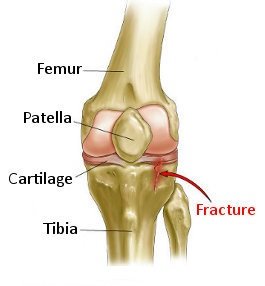Tibial Plateau Fracture

Symptoms
The tibial plateau is the tip surface of the shinbone (tibia) and is part of the knee joint. A tibial plateau fracture is break that occurs involving the knee joint surface and extends into the lower leg (tibia).
Causes
Tibial plateau fractures occur when a force is placed on the bone that is greater than it can withstand (i.e.an impaction injury)
- Direct hit (trauma) to the tibial plateau.
- Indirect trauma, such as a twisting or bending injury or “loading” the joint
- This is seen commonly with skiing
Risk increases with:
- Contact Sports
- Snow Sports, Motor Sports
- Bone disease (osteoporosis)
- Metabolism disorders, hormone problems, nutritional deficiency or eating disorders (anorexia, bulimia).
Prevention
- Warm up and stretch properly before activity
- Maintain physical fitness:
- Strength (especially core), flexibility and endurance
- Cardiovascular fitness
- Wear properly fitted and padded protective equipment
Treatment
Treatment first involves the use of ice and medicine to reduce pain and inflammation.
If the bone fragments are out of alignment (displaced fracture), immediate realignment of the bone (reduction) is required.
Fractures that cannot be realigned or are open (bones poking through the skin), may require surgery to hold the fracture in place with screws, pins and plates.
Once the bone is aligned or surgically fixed, the knee is usually placed in a hinged brace for support and to allow early motion.
Non-weight bearing with crutch-assisted walking is usually required for 6-12 months to allow sufficient healing of the bone and joint surface to occur.


